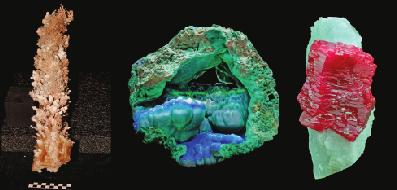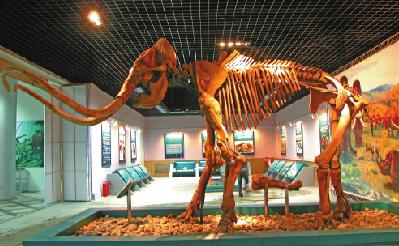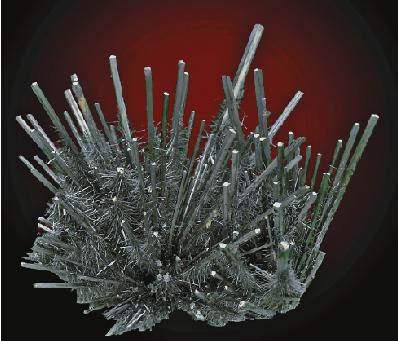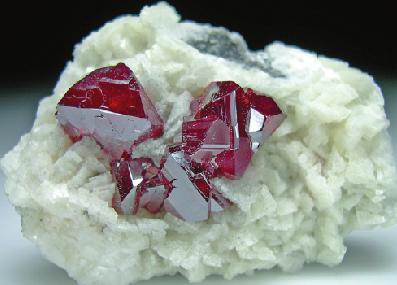Stone and gem collectors from across the world will have their eyes on Changsha, the capital of Hunan province in Central China, when it hosts Asia's largest mineral-themed exhibition from May 15 to 20.
Organized by Hunan's provincial government and the Ministry of Land and Resources, the China (Changsha) Mineral and Gem Show will offer 2,000 booths on a floor space of 65,000 meters for exhibitors to showcase minerals, fossils, meteorites and handicrafts.
Exhibit highlights include a 30,000-year-old fossil of a mammoth unearthed in Siberia and the Rose of Asia from the Milan Museum of Natural History. At 35 cm tall it is the world's finest elbaite tourmaline specimen.
Other items that are sure to impress visitors include a plesiosaur fossil from Australia, rubies from Burma's Mogok, which has one of the world's best gem mines, copper and manganese minerals from the United States and mineral products from Hunan.
The show has attracted big names in the industry.
NASA's chief mineral research scientist, Robert Downs, the Milan Museum of National History's curator, Federico Pezzotta, former chairman of the International Mineralogical Association, Xie Xiande, and the US Museum of Natural History's curator, Gorge Harlow, will deliver keynote speeches at a summit meeting at the exhibition.
The show will include a seminar on the jewelry industry and culture and a fossil forum, where scientists and industry insiders will share their knowledge with the audience, according to organizers.
"Minerals and fossils contain a huge amount of information about the universe, which would promote the progress of human civilization," said Jiang Jianjun, director of science and international cooperation at the Ministry of Land and Resources.
Astrochemist and geochemist Ouyang Ziyuan, also a chief scientist at China's lunar program, said it is his duty to help promote science. He emphasized that China's rapid industrialization requires more people to have geochemical knowledge.
It is hoped that the show will help ignite young people's enthusiasm for geology and they will receive popular science books.
"This will contribute to the popularity of popular science and enhance their understanding of natural science," said Jiang.
Organizers expect the event to be an even greater success than it was last year. Launched in May 2013, the show attracted 1,200 exhibitors from 54 countries and regions and 150,000 visitors. Deals worth more than 1 billion yuan were signed at the show last year.
Rich mineral resources
Hunan has diverse natural habitats, which attract people from around the world.
The province has 17 UNESCO world natural heritage sites, including the internationally renowned Wulingyuan and Langshan mountains.
Experts said it is rare for so many picturesque tourist spots to be concentrated in one place, which local government officials consider to be a remarkable natural resource advantage.
The province and surroundings in southern Jiangxi and Hubei province as well as northern Sichuan, Guizhou and Guangdong provinces form China's most important cluster of geological zones, with abundant mineral deposits, particularly crystal mines.
China's mineral resources are very important to the world and many international exhibitions in the field, including the Tucson and Munich mineral shows, have introduced Chinese Day activities.
International museums and famous collectors believe products from China's dozens of crystal mines are indispensable.
Hunan has 22 world-class geological parks. It has reserves of non-ferrous metals that account for two thirds of the country's total and one third of the world's total. The province also discovered more than 90 percent of the world's antimony deposits.
Hunan is home to 141 types of minerals with diverse colors and unique shapes, including some rare and iconic species.
In 1982, China Post issued stamps of four famous crystal minerals all from Hunan. They are realgar, cinnabar, antimony and wolframite.
The expo attracted huge attention at its first session last year because "collectors and exhibitors across the world have fully recognized the value of Hunan mineral resources and see the profit potential in Chinese markets," industry insiders said.
Contact the writers at fengzhiwei@chinadaily.com.cn, lifusheng@chinadaily.com.cn, and haonan@chinadaily.com.cn
NUMBERS
1,200 exhibitors from 54 countries and regions and 150,000 visitors in the exhibition in 2013.
1 billion yuan worth of deals were signed at the show last year.
17 UNESCO world natural heritage sites in Hunan.
22 world-class geological parks in the province.
141 kinds of minerals found in Hunan.
 CHINA DAILY
CHINA DAILY
Precious minerals are expected to be on display at the China (Changsha) Mineral and Gem Show, including the specimen (left) from Bisbee mine, in Arizona, the United States; the 500-kg malachite and azurite geode (center) from the Liufeng Mountains in Anhui province; and the 1,700-carat ruby (right) from Burma's Mogok.

CHINA DAILY
The well-preserved mammoth fossil unearthed in Siberia is expected to be a highlight at the expo.

CHINA DAILY
Antimonite from Lengshuijiang, Hunan province

CHINA DAILY
Cinnabar from Chatian, Fenghuang county, Hunan province.